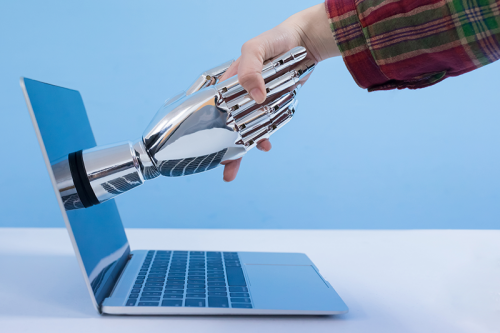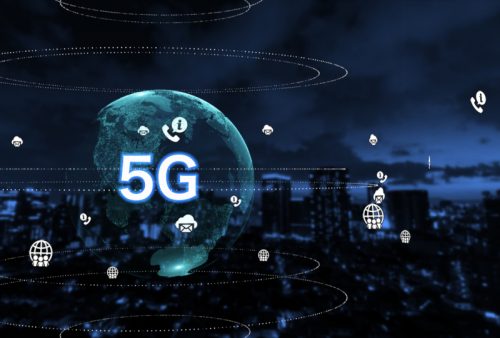Blog May. 09, 2018
Virtual Assistant: The Future of Customer Interactions

Customer support is an essential part of every growing business; continuously developing in order to improve customer interactions. With the advanced evolution of technologies like AI-enabled communication, chatbots are quickly gaining its popularity in every industry and it’s simple to ascertain why.
What exactly is a chatbot?
It is a computer program that is designed to conduct a conversation via auditory or textual methods and simulates with human users over the internet. It can manage to reply by exchanging conversation through messaging apps, chat windows or even through voice.
This emerging technology makes it easier for businesses to have smooth first interactions with their customers, lessen the weight on their workload and proactively prevent minor customer service problems from turning into major issues.
Over the past years, chatbots have organized more modern techniques to understand user questions and produce consistent and useful responses. Today, it is able to provide more functions on such platforms all within a messaging conversation.
Opportunities in chatbot industry are something that cannot be ignored.
According to the report of Ubisend 2016, 45.8% of users would rather communicate with a business through a messaging app rather than email. In this mobile-first world, people desire to get information quickly at the press of the button, meaning to say the customer’s demands businesses to interact more with them, whether human to human or an automated response.
A survey by Aspect found 71% of the customer are looking to resolve their concerns without the help of another person. More than 60% of respondents claimed chatbots are helpful, easy to use and fast. These numbers show that it is growing necessity for industries to keep up with this trend in technologies.
Chatbots serve as a helpful assistant to humankind.
In customer service and customer relationship management, chatbots are programmed to work as an agent representative in order to:
- Help businesses by acting as a touchpoint and handle the first encounter to every user.
- Reduce human effort and inquiries volume by handling simple issues and automatically escalate the complicated questions.
- Reduce the average handling time (AHT) and expand the hours of availability, in fact, chatbots can work straight 24/7.
- Helps the user to get their desired answers promptly especially if the solution they are looking for are well known and predictable such as troubleshooting and other scripted answers which AI can solve without the help of a human.
- A well-designed system can use a natural language processing to understand a customer’s request that is faster than selecting multiple options to answers customer inquiry such as “What color are still available?” or “Could you rebook my flight to Japan on to the following Friday 1 am and get me a window seat?”.
Chatbot technology has yet to be perfected, companies are still in the process of development.
Chatbots can be programmed to respond templated questions. However, businesses have to understand well how chatbots work.
- Chatbots are not fitted for every company, as the programming may or may not be suitable it depending on your business type and the needs of your customers.
- Not all chatbots are up to the stage of keeping in mind the goals of customer experience and retention.
- Even though chatbots are faster and flexible with the hours of availability they can still make mistakes and not be 100% accurate in interpreting human nuances.
- There is a lot of time, budget, and effort to spend in the analysis for the development and optimization of chatbots.
- There are some qualities that are vital for every customer support provider that is hard for a machine to imitate and that is empathy.
Why is it significant to classify responsibilities for a chatbot?
Given that chatbots are not fitted for every business, it is necessary to know exactly what your business wants to achieve before initiating a chatbot. Analyzing your business needs is important, for example, do you want to:
- Provide a quick day-and-night answer to the common questions?
- Cutting down the volume of common emails that your business receives?
- Allow your customer service agents to resolve a more difficult customer issue?
Enlisting the task that you want to trust your virtual assistant with will let you identify the goal of your customer service chatbot.
Virtual Assistant: Transforming the Future Business and Customer Experience

Work power and cost-savings are the current benefits of the chatbots that are still under discussion across the world. A study by Juniper Research predicts that by the year 2020, chatbots will save businesses 70 cents per customer transaction. This will add up to a total of $8 billion in cost savings globally.
The future of a chatbot in the industry depends a lot on the advancements in AI. Today, it is observed that chatbots are truly interesting and has the potential but the level as to how much it can completely replace humans are unknown. There will also be new challenges in terms of developing and optimizing the technology itself. Even so, there is no denial that chatbots are becoming an important part of the digital customer service as an exceptional assistant that industries are excited to see what it will become in the near future.
With the continuous development of chatbots, no one knows when it can truly resemble a real human-like experience. It’s still a long way. That’s why for now, humans still need to do the work having an organized support team until AI is perfected.








